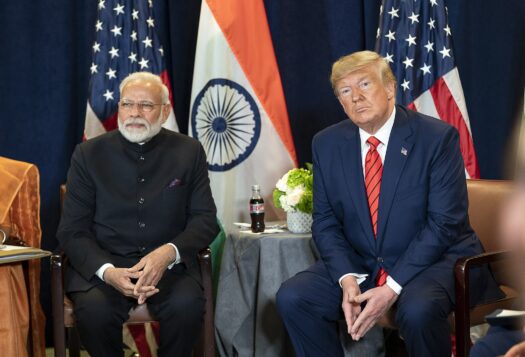
A conversation at an auto-rickshaw stand in New Delhi on the evening of December 25, 2015:
Guy 1: “Acha ye bataiye, hamare pradhan mantri Pakistan me kya kar rahe hain?” (“Tell me one thing, what’s our PM doing in Pakistan?”)
Guy 2: “Wo gaye they na Afghanistan kuch udghatan karne. Waapsi me Pakistan pada to kuch unke pradhan mantri ke birthday party par ho aye.” (“He had gone to Afghanistan to inaugurate something. Pakistan was on the way, so he attended their PM’s birthday party on his onward journey.”)
Guy 1: “Aise hi chale gaye? Bharat Pakistan dost hain kya?” (“He went just like that? Are India and Pakistan friends or something now?”)
Guy 2: “Keh to rahe hain. Wo rehne dijiye ring road par traffic ki kya haalat hai?” (They’re saying so. Anyway, what’s the traffic situation on the ring road?)
This conversation summed up almost everything about the twists and turns of the India-Pakistan relationship. It not only illustrated the general curiosity about the bilateral among general citizens, but it also showed how pointless it has become to get excited about any development on that front.
This year, the Indo-Pak relationship had yet again been the same old story of that on-again off-again couple on your social media list whose updates you’re tired of – enough to make you consider un-following their updates (because deleting them from your list is not something you want to do but constant updates of their oscillating relationship is plain tiresome).
Well, almost.
As the year neared its end, and we all geared up to get routinely weary of thinking about clever ways to say the exact same thing about the bilateral that people have said for the past many years, December came (thankfully!) with some substance to draw from. The Indian and Pakistani national security advisors successfully met and spoke in Bangkok (after the predictable epic fail of August); the Indian minister of external affairs visited Islamabad for the Heart of Asia summit; and as a cherry on top, our prime minister, on his way home to New Delhi from Kabul, made a surprise stopover in Lahore to meet his Pakistani counterpart.
Were New Delhi and Islamabad worried about what Santa would think? Maybe; but not entirely though. Nonetheless, there does appear to be some alteration in calculation – more importantly in the Pakistan Army.
Given the superb (yes, sarcasm) track record of friendship both sides share with each other, this awesomesauce (forced sarcasm again, my apologies) relationship is now so predictable that even aliens might be contemplating going on dharnas to protest the lack of originality in the bickering. Maybe Mangalyaan relayed the Martians’ sentiments about how boring earth-watching has become.
Anyway, whether or not the Martians want Achche Din, Indian Prime Minister Narendra Modi’s Lahore stopover is indeed a welcome development, and potentially sets the tone not just for Indo-Pak relations and the upcoming SAARC summit in Islamabad, but also for movement on other regional issues, especially security, stability, and the economy. That this came as the last leg of his journey to Moscow and from there to Kabul, onward to New Delhi, is also telling. Regionally, it could be India vocalising its stance that it isn’t averse to cooperating with Pakistan on resolving issues regarding Afghanistan, regional security, and energy trade.
[Random thought interjection: So is ‘sabka saath sabka vikas’ going regional? Errmm…]Moving on, that this visit went smoothly indicates that the Pakistan Army might not be entirely averse to improving relations with India for various reasons.
All this will go well and good until this reaches our ever-effective Achilles Heel: timely follow-up, the bane of our existence.
Any sustainable progress in the bilateral rests entirely on how well both sides follow up to capitalise on and harness the superb and unprecedented momentum that has been built up in a span of one month – the achievement of which proves that if both countries set their minds to it, they can indeed make something happen.
If winged well, working together to help secure Afghanistan’s stability could in fact have the potential to pave way for turning Indo-Pak relations around; India isn’t entirely unwilling to consider that – as may have been implied in December, especially the 25th.
Bilateral and regional common minimums have to be identified and worked towards, to start off with.
If not, I for one would expect a daft but outlandish saga a la the ultimate BFFs (best friends forever), Mudasir, Asif, and Salman.
Maybe us momentary BFFs of a fraction of a dot can move forward by channelling our energies towards a separate entity – it could be towards development and trade cooperation, or even via cooperation against the Islamic State and the like. Smaller initiatives could precede hefty undertakings, if genuine success is sought.
Regardless, we must admit that in all the highs and lows we witnessed, 2015 would not have ended without ample dollops of entertainment – some more exciting than others – in addition to the usual dosages of banal drama.
Now, to answer the opening question: are we going to be sincere, responsible neighbours, or are we being nice because it is the season to be so?
Perhaps the answer is both, in varying degrees. The next six months will shed some light.
***
Image: Anadolu Agency-AFP, Getty


